cruise control LAND ROVER DISCOVERY 2002 User Guide
[x] Cancel search | Manufacturer: LAND ROVER, Model Year: 2002, Model line: DISCOVERY, Model: LAND ROVER DISCOVERY 2002Pages: 1672, PDF Size: 46.1 MB
Page 419 of 1672
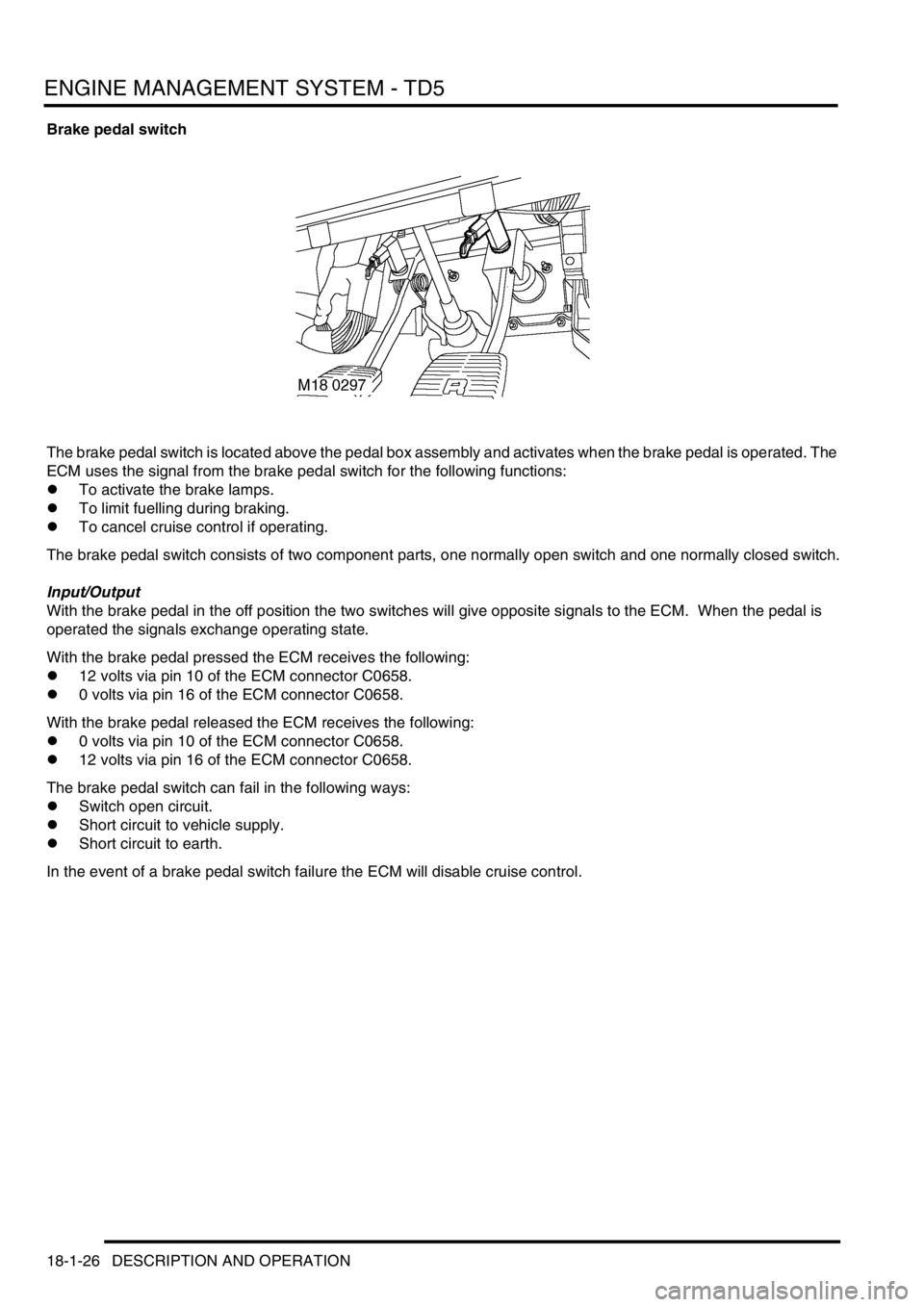
ENGINE MANAGEMENT SYSTEM - TD5
18-1-26 DESCRIPTION AND OPERATION
Brake pedal switch
The brake pedal switch is located above the pedal box assembly and activates when the brake pedal is operated. The
ECM uses the signal from the brake pedal switch for the following functions:
lTo activate the brake lamps.
lTo limit fuelling during braking.
lTo cancel cruise control if operating.
The brake pedal switch consists of two component parts, one normally open switch and one normally closed switch.
Input/Output
With the brake pedal in the off position the two switches will give opposite signals to the ECM. When the pedal is
operated the signals exchange operating state.
With the brake pedal pressed the ECM receives the following:
l12 volts via pin 10 of the ECM connector C0658.
l0 volts via pin 16 of the ECM connector C0658.
With the brake pedal released the ECM receives the following:
l0 volts via pin 10 of the ECM connector C0658.
l12 volts via pin 16 of the ECM connector C0658.
The brake pedal switch can fail in the following ways:
lSwitch open circuit.
lShort circuit to vehicle supply.
lShort circuit to earth.
In the event of a brake pedal switch failure the ECM will disable cruise control.
Page 420 of 1672
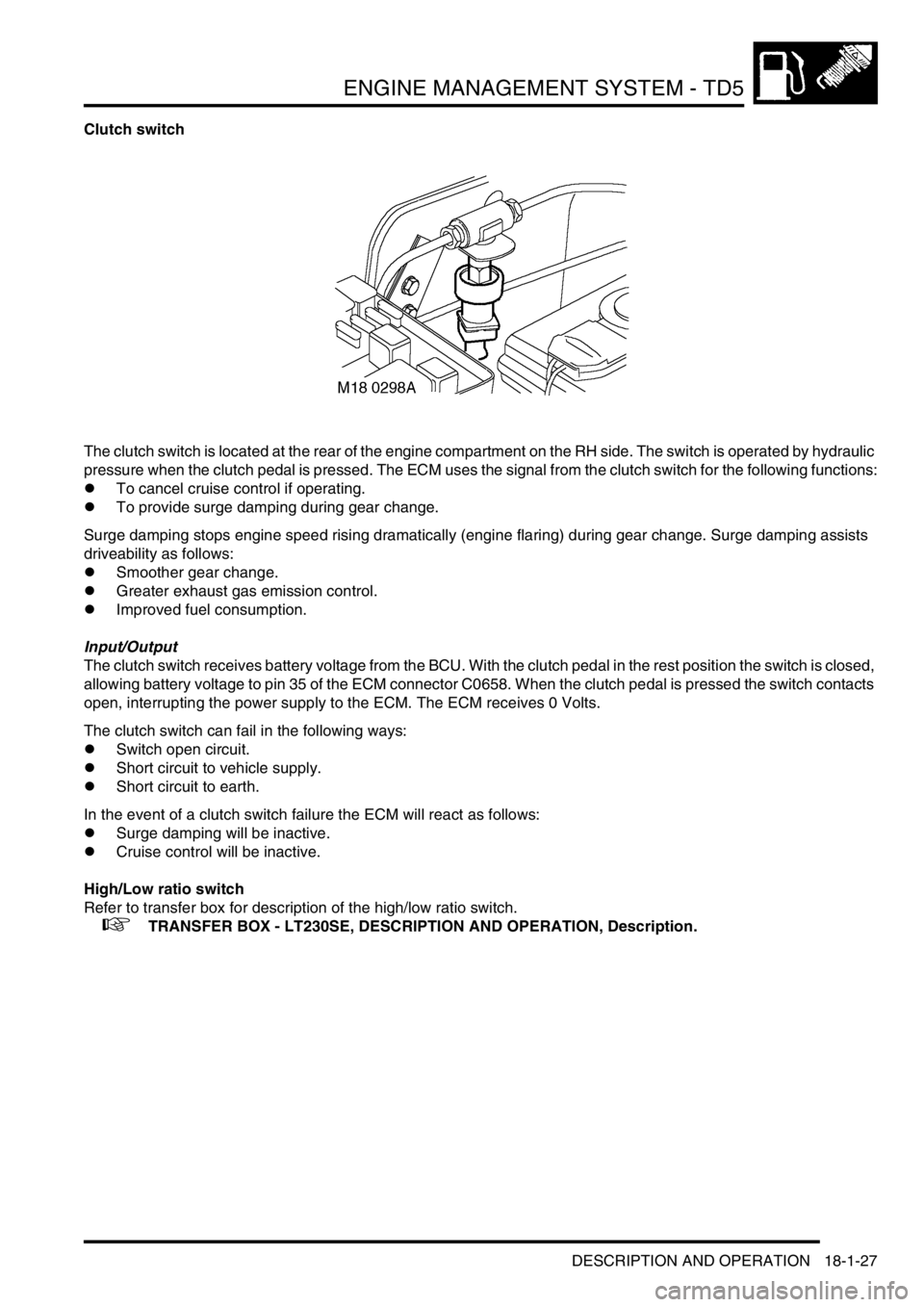
ENGINE MANAGEMENT SYSTEM - TD5
DESCRIPTION AND OPERATION 18-1-27
Clutch switch
The clutch switch is located at the rear of the engine compartment on the RH side. The switch is operated by hydraulic
pressure when the clutch pedal is pressed. The ECM uses the signal from the clutch switch for the following functions:
lTo cancel cruise control if operating.
lTo provide surge damping during gear change.
Surge damping stops engine speed rising dramatically (engine flaring) during gear change. Surge damping assists
driveability as follows:
lSmoother gear change.
lGreater exhaust gas emission control.
lImproved fuel consumption.
Input/Output
The clutch switch receives battery voltage from the BCU. With the clutch pedal in the rest position the switch is closed,
allowing battery voltage to pin 35 of the ECM connector C0658. When the clutch pedal is pressed the switch contacts
open, interrupting the power supply to the ECM. The ECM receives 0 Volts.
The clutch switch can fail in the following ways:
lSwitch open circuit.
lShort circuit to vehicle supply.
lShort circuit to earth.
In the event of a clutch switch failure the ECM will react as follows:
lSurge damping will be inactive.
lCruise control will be inactive.
High/Low ratio switch
Refer to transfer box for description of the high/low ratio switch.
+ TRANSFER BOX - LT230SE, DESCRIPTION AND OPERATION, Description.
Page 428 of 1672
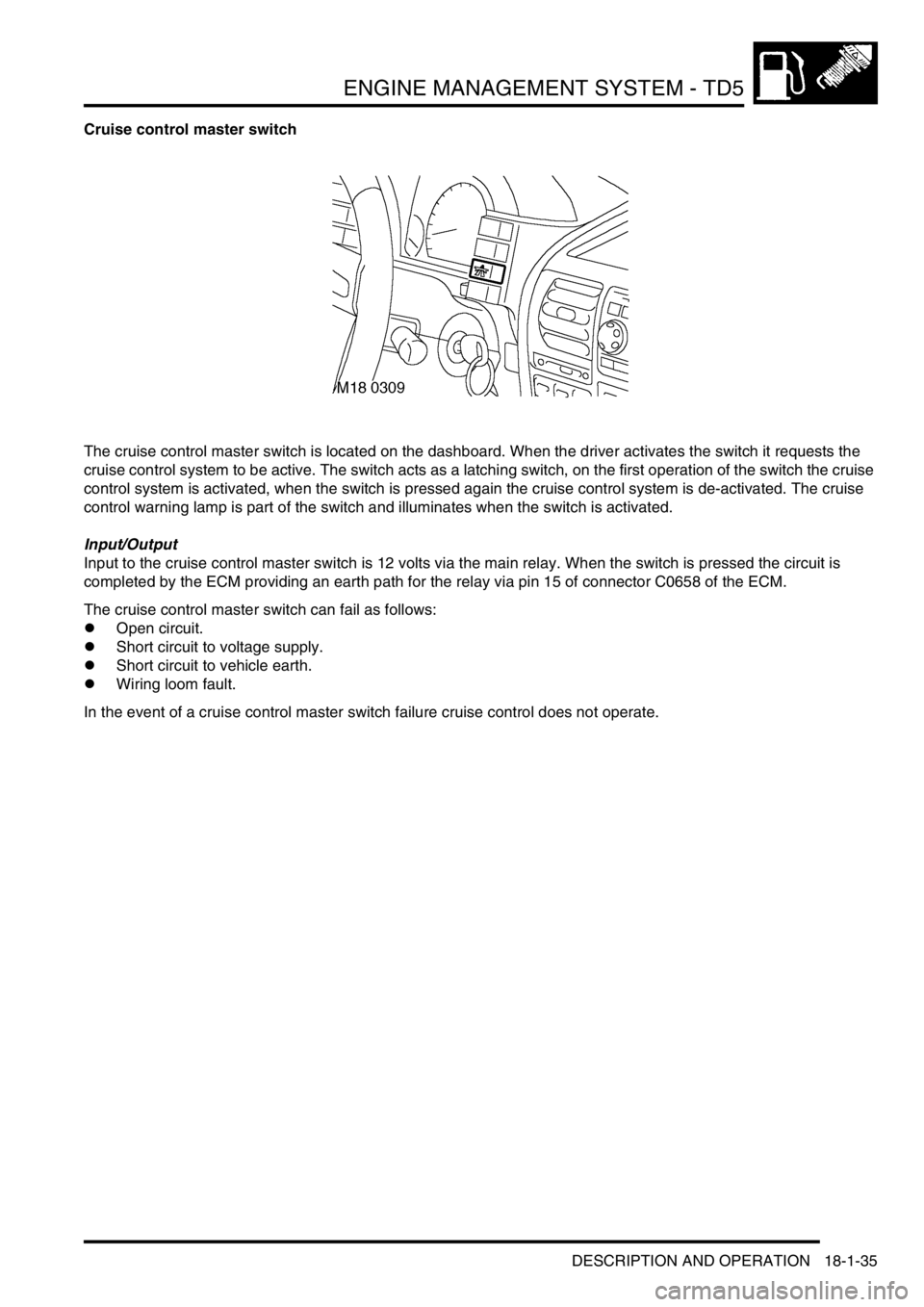
ENGINE MANAGEMENT SYSTEM - TD5
DESCRIPTION AND OPERATION 18-1-35
Cruise control master switch
The cruise control master switch is located on the dashboard. When the driver activates the switch it requests the
cruise control system to be active. The switch acts as a latching switch, on the first operation of the switch the cruise
control system is activated, when the switch is pressed again the cruise control system is de-activated. The cruise
control warning lamp is part of the switch and illuminates when the switch is activated.
Input/Output
Input to the cruise control master switch is 12 volts via the main relay. When the switch is pressed the circuit is
completed by the ECM providing an earth path for the relay via pin 15 of connector C0658 of the ECM.
The cruise control master switch can fail as follows:
lOpen circuit.
lShort circuit to voltage supply.
lShort circuit to vehicle earth.
lWiring loom fault.
In the event of a cruise control master switch failure cruise control does not operate.
Page 429 of 1672
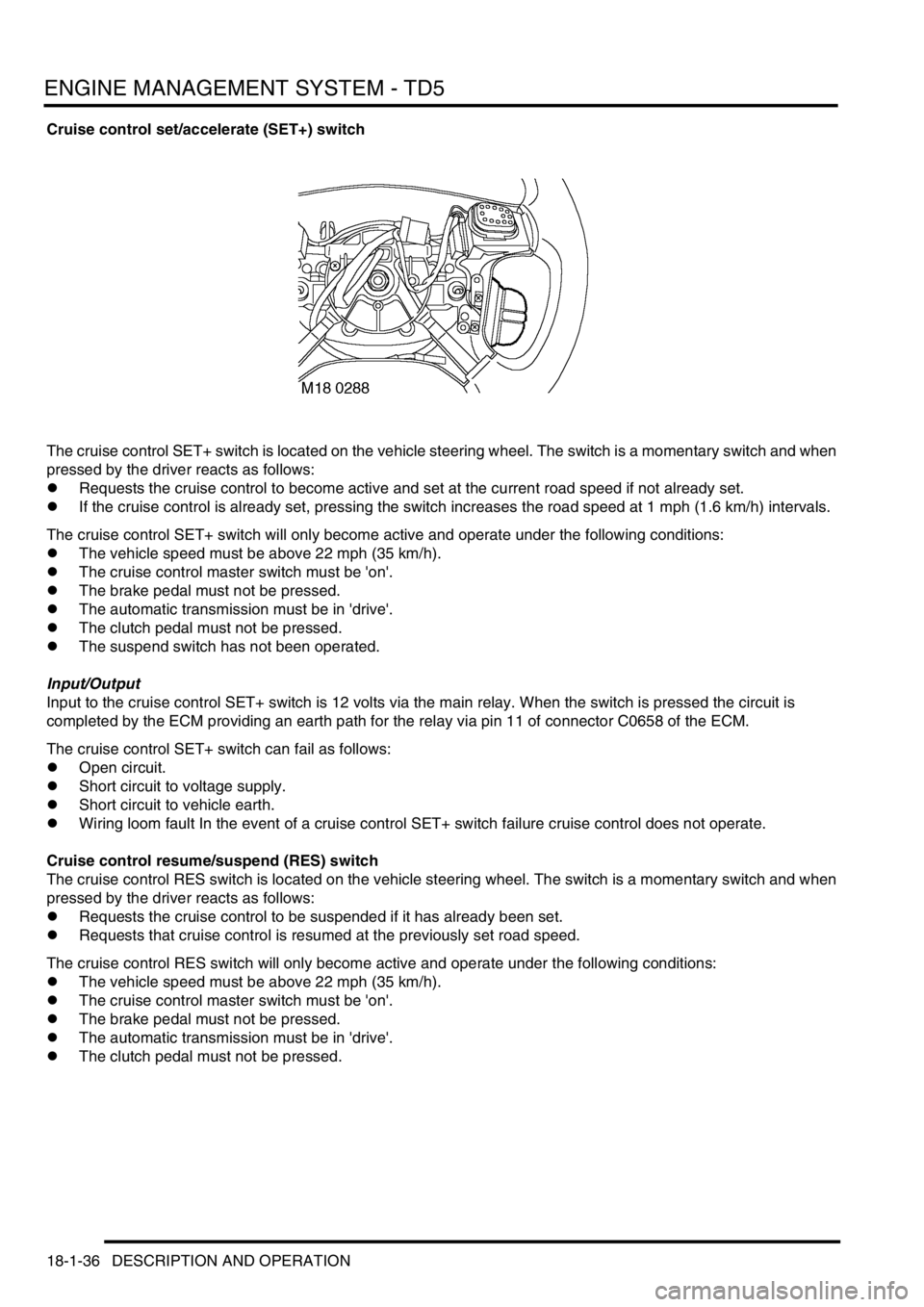
ENGINE MANAGEMENT SYSTEM - TD5
18-1-36 DESCRIPTION AND OPERATION
Cruise control set/accelerate (SET+) switch
The cruise control SET+ switch is located on the vehicle steering wheel. The switch is a momentary switch and when
pressed by the driver reacts as follows:
lRequests the cruise control to become active and set at the current road speed if not already set.
lIf the cruise control is already set, pressing the switch increases the road speed at 1 mph (1.6 km/h) intervals.
The cruise control SET+ switch will only become active and operate under the following conditions:
lThe vehicle speed must be above 22 mph (35 km/h).
lThe cruise control master switch must be 'on'.
lThe brake pedal must not be pressed.
lThe automatic transmission must be in 'drive'.
lThe clutch pedal must not be pressed.
lThe suspend switch has not been operated.
Input/Output
Input to the cruise control SET+ switch is 12 volts via the main relay. When the switch is pressed the circuit is
completed by the ECM providing an earth path for the relay via pin 11 of connector C0658 of the ECM.
The cruise control SET+ switch can fail as follows:
lOpen circuit.
lShort circuit to voltage supply.
lShort circuit to vehicle earth.
lWiring loom fault In the event of a cruise control SET+ switch failure cruise control does not operate.
Cruise control resume/suspend (RES) switch
The cruise control RES switch is located on the vehicle steering wheel. The switch is a momentary switch and when
pressed by the driver reacts as follows:
lRequests the cruise control to be suspended if it has already been set.
lRequests that cruise control is resumed at the previously set road speed.
The cruise control RES switch will only become active and operate under the following conditions:
lThe vehicle speed must be above 22 mph (35 km/h).
lThe cruise control master switch must be 'on'.
lThe brake pedal must not be pressed.
lThe automatic transmission must be in 'drive'.
lThe clutch pedal must not be pressed.
Page 430 of 1672

ENGINE MANAGEMENT SYSTEM - TD5
DESCRIPTION AND OPERATION 18-1-37
Input/Output
Input to the cruise control RES switch is 12 volts via the main relay. When the switch is pressed the circuit is completed
by the ECM providing an earth path for the relay via pin 17 of connector C0658 of the ECM.
The cruise control RES switch can fail as follows:
lOpen circuit.
lShort circuit to voltage supply.
lShort circuit to vehicle earth.
lWiring loom fault.
In the event of a cruise control RES switch failure cruise control resume/ suspend operation does not operate.
Page 434 of 1672

ENGINE MANAGEMENT SYSTEM - TD5
DESCRIPTION AND OPERATION 18-1-41
In the case of a VSS failure on vehicles with automatic transmissions the ECM applies default values derived from
the EAT ECU. There is no default value for manual transmission vehicle.
The VSS can fail in the following ways:
lWiring short circuit to vehicle supply.
lWiring short circuit to vehicle earth.
lWiring open circuit.
In the event of a VSS failure any of the following symptoms may be observed:
lVehicle speed limiting disabled (manual transmission only).
lHill Descent Control (HDC) warning lamp on and audible warning.
Cruise control
All markets have a common cruise control system. The cruise control system, when activated, regulates vehicle
speed. The ECM controls the cruise control system.
Cruise control activation
Cruise control is a passive system, and must be activated by the driver. Cruise control is activated by switching on
the cruise control master switch located on the instrument panel. A LED in the switch illuminates indicating cruise
control is available. The driver must accelerate the vehicle to the desired speed using the accelerator pedal. When
the desired speed is reached, cruise control can be activated by pressing the SET+ switch.
Cruise control will only activate if the following conditions are met:
lVehicle speed is above 22 mph (35 km/h).
lThe brake pedal is not pressed.
lThe clutch pedal is not pressed (manual transmission only).
lThe transmission is not in Park, Reverse or Neutral (automatic transmission only).
The ECM receives the set signal and determines the vehicle speed provided by the SLABS ECU. The ECM then
maintains current road speed.
Cruise control cancellation
Cancelling cruise control enables the driver to regain control of the vehicle speed by using the accelerator pedal.
Cruise control is cancelled if any of the following conditions occur:
lThe brake pedal is pressed.
lThe RES switch is pressed.
lThe clutch pedal is pressed (manual transmission only).
lThe cruise control master switch is switched off.
lThe transmission is placed in Park, Neutral, or Reverse (automatic transmission only).
The ECM cancels cruise control operation and returns it to the control of the accelerator pedal.
The set speed will be stored in the ECM unless:
lThe cruise control master switch is switched off.
lThe ignition is switched off.
If cruise control is deactivated using either of the above methods, the set speed will be erased from the memory of
the ECM.
Page 435 of 1672

ENGINE MANAGEMENT SYSTEM - TD5
18-1-42 DESCRIPTION AND OPERATION
Cruise control resumption
Cruise control can be resumed at the previously set speed, provided the set speed has not been erased from the
ECM's memory as described above.
To resume cruise control operation to the previously set speed, depress the RES switch once when the following
conditions are met:
lA set speed is stored in the ECM.
lVehicle speed is above 22 mph (35 km/h).
lThe brake pedal is not pressed.
lThe clutch pedal is not pressed (manual transmission only).
lThe transmission is not in Park, Reverse or Neutral (automatic transmission only).
The ECM activates the cruise control system at the stored speed.
Accelerating while cruise control is active
There are three ways of increasing vehicle speed when cruise control is active:
lTemporarily increase vehicle speed (e.g. when overtaking another vehicle).
lIncrease vehicle set speed in 1 mph (1.5 km/h) increments.
lIncrease vehicle set speed.
To temporarily increase vehicle speed press the accelerator pedal until the desired speed is reached.
When the accelerator pedal is released, the vehicle coasts back to the set speed. When it reaches the set speed,
cruise control operation continues.
To increase the vehicle set speed in 1 mph (1.5 km/h) increments, tap the SET+ switch. Each tap on the switch
increases vehicle speed.
To increase the vehicle set speed, press and hold the SET+ switch until the desired set speed is reached.
Vehicle set speed will increase if the following conditions are met:
lThe vehicle is under cruise control operation.
lVehicle speed is above 22 mph (35 km/h).
lThe brake pedal is not pressed.
lThe clutch pedal is not pressed (manual transmission only).
lThe transmission is not in Park, Reverse or Neutral (automatic transmission only).
The vehicle responds as follows:
lIf the driver accelerates using the throttle pedal, the ECM increases vehicle speed using the TP sensor signal.
When the driver releases the accelerator pedal, the vehicle returns to the set speed.
lIf the SET+ switch is tapped the stored speed and vehicle speed increases by 1 mph (1.5 km/h) per tap on the
switch.
lIf the driver presses and holds the SET+ switch the vehicle speed will increase and will hold the speed when the
switch is released.
Switching off cruise control
Switching off cruise control allows the driver to regain control of vehicle speed, and erases the set road speed from
the ECM's memory.
To switch off cruise control, press the cruise control master switch to the off position.
When the cruise control master switch is switched off, the ECM deactivates cruise control and the driver regains
control of vehicle speed.
Page 455 of 1672

ENGINE MANAGEMENT SYSTEM - TD5
18-1-62 REPAIRS
Refit
1.Clean injector units and mating faces in
cylinder head.
2.Using LRT-12-154/2, fit a new 'O' ring to each
injector.
3.Using LRT-12-154/3, fit a new sealing washer
to each injector.
4.Fit retainer to injector. Carefully fit injector,
ensuring retainer is located on its dowel, and
tighten Torx bolt to 32 Nm (24 lbf.ft)
5.Connect multiplug to injector.
6.Repeat above operations for remaining
injectors.
7.Connect fuel hoses to connector block and fuel
cooler.
8.Programme new injectors using TestBook.
9.Fit rocker shaft.
+ ENGINE - Td5, REPAIRS, Rocker
shaft assembly.
10.Fit cooling fan.
+ COOLING SYSTEM - Td5, REPAIRS,
Fan - viscous.
Switch - cruise control (on/off)
$% 19.75.30
Remove
1.Carefully remove switch from instrument cowl.
2.Disconnect multiplug and remove switch.
Refit
1.Position new switch and connect multiplug.
2.Carefully push switch into instrument cowl.
Page 456 of 1672

ENGINE MANAGEMENT SYSTEM - TD5
REPAIRS 18-1-63
Switch - cruise control (set/resume)
$% 19.75.33
Remove
1.Remove the key from the starter switch.
Disconnect both battery leads, negative lead
first. Wait ten minutes before starting work.
2.Remove driver's airbag module.
+ RESTRAINT SYSTEMS, REPAIRS,
Airbag module - drivers.
3.Release remote control switches multiplug and
leads from steering wheel base.
4.Disconnect remote control switches multiplug
from harness.
5.Remove 2 screws securing remote control
switches to steering wheel base.
6.Release and remove remote control switches
from steering wheel.
Refit
1.Fit remote control switches to steering wheel
and secure with screws.
2.Connect remote control switches multiplug to
harness.
3.Secure leads and multiplug to base of steering
wheel.
4.Fit driver's airbag module.
+ RESTRAINT SYSTEMS, REPAIRS,
Airbag module - drivers.
Switch - clutch
$% 19.75.34
Remove
1.Disconnect the multiplug from the clutch switch.
2.Position a container below the clutch switch to
collect the fluid.
3.Unscrew and remove the clutch switch.
CAUTION: Always fit plugs to open
connections to prevent contamination.
Refit
1.Fit the clutch switch and tighten to 10 Nm (7
lbf.ft).
2.Connect the multiplug.
3.Bleed the clutch hydraulic system.
+ CLUTCH - Td5, ADJUSTMENTS,
Clutch hydraulic system - bleed.
Page 464 of 1672
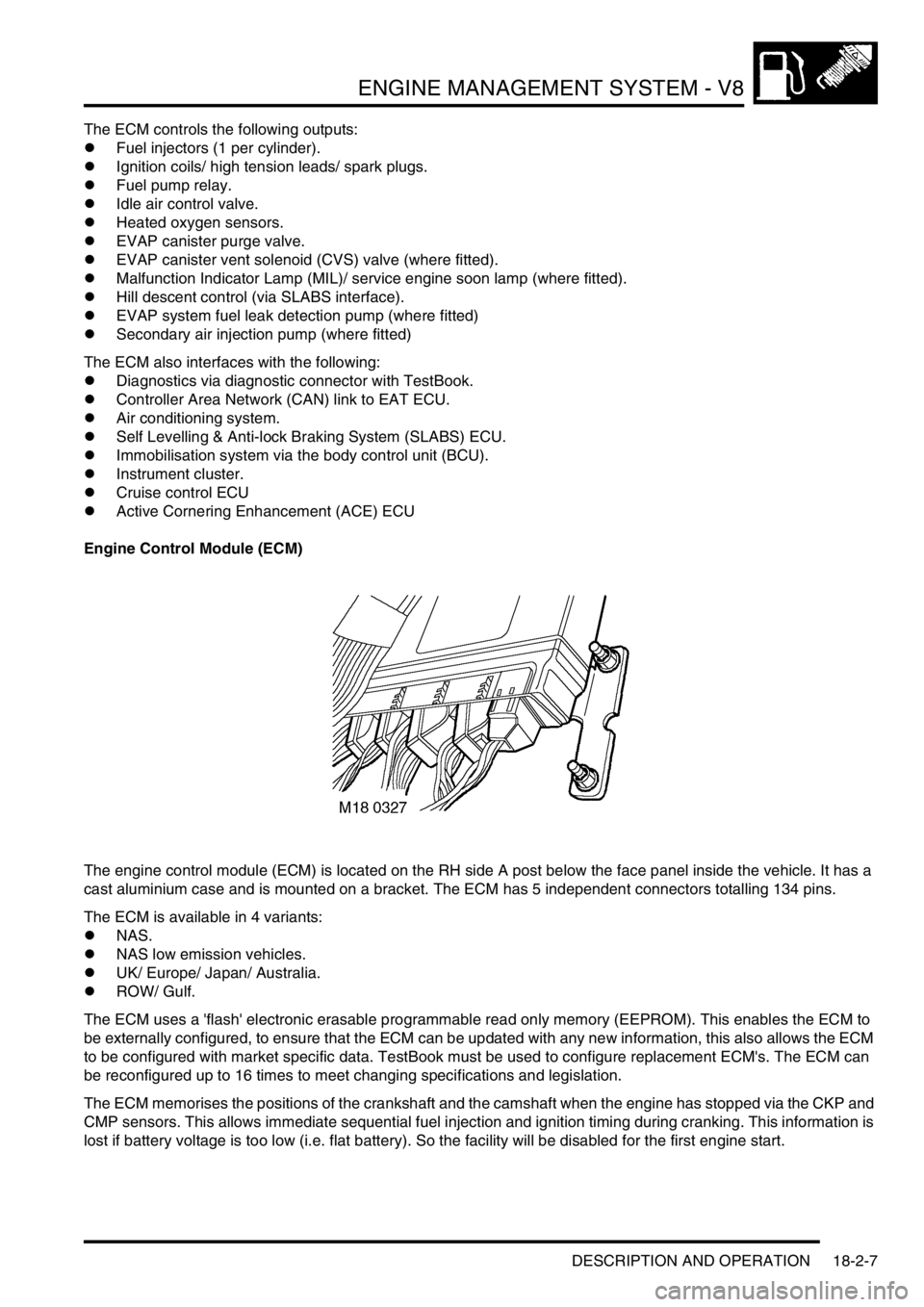
ENGINE MANAGEMENT SYSTEM - V8
DESCRIPTION AND OPERATION 18-2-7
The ECM controls the following outputs:
lFuel injectors (1 per cylinder).
lIgnition coils/ high tension leads/ spark plugs.
lFuel pump relay.
lIdle air control valve.
lHeated oxygen sensors.
lEVAP canister purge valve.
lEVAP canister vent solenoid (CVS) valve (where fitted).
lMalfunction Indicator Lamp (MIL)/ service engine soon lamp (where fitted).
lHill descent control (via SLABS interface).
lEVAP system fuel leak detection pump (where fitted)
lSecondary air injection pump (where fitted)
The ECM also interfaces with the following:
lDiagnostics via diagnostic connector with TestBook.
lController Area Network (CAN) link to EAT ECU.
lAir conditioning system.
lSelf Levelling & Anti-lock Braking System (SLABS) ECU.
lImmobilisation system via the body control unit (BCU).
lInstrument cluster.
lCruise control ECU
lActive Cornering Enhancement (ACE) ECU
Engine Control Module (ECM)
The engine control module (ECM) is located on the RH side A post below the face panel inside the vehicle. It has a
cast aluminium case and is mounted on a bracket. The ECM has 5 independent connectors totalling 134 pins.
The ECM is available in 4 variants:
lNAS.
lNAS low emission vehicles.
lUK/ Europe/ Japan/ Australia.
lROW/ Gulf.
The ECM uses a 'flash' electronic erasable programmable read only memory (EEPROM). This enables the ECM to
be externally configured, to ensure that the ECM can be updated with any new information, this also allows the ECM
to be configured with market specific data. TestBook must be used to configure replacement ECM's. The ECM can
be reconfigured up to 16 times to meet changing specifications and legislation.
The ECM memorises the positions of the crankshaft and the camshaft when the engine has stopped via the CKP and
CMP sensors. This allows immediate sequential fuel injection and ignition timing during cranking. This information is
lost if battery voltage is too low (i.e. flat battery). So the facility will be disabled for the first engine start.